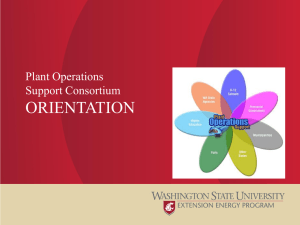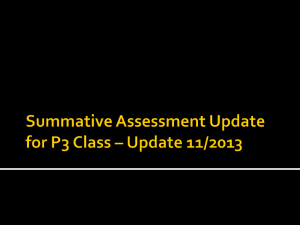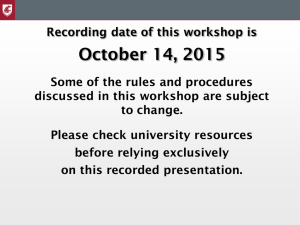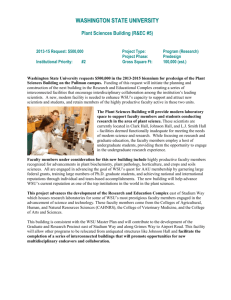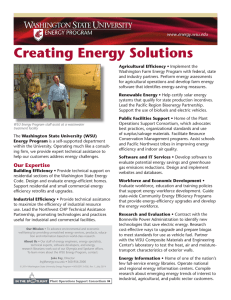2 Inside Consortium rolls out energy advisory services
advertisement
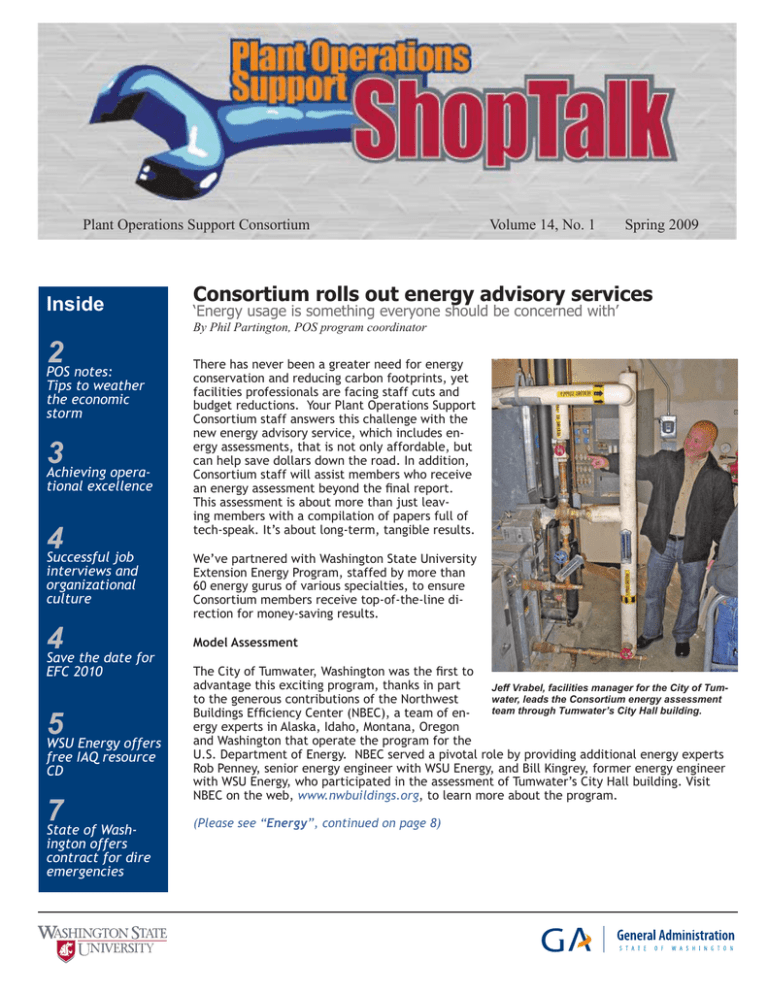
Plant Operations Support Consortium Inside Volume 14, No. 1 Spring 2009 Consortium rolls out energy advisory services ‘Energy usage is something everyone should be concerned with’ By Phil Partington, POS program coordinator 2 POS notes: Tips to weather the economic storm 3 Achieving opera- tional excellence 4 Successful job There has never been a greater need for energy conservation and reducing carbon footprints, yet facilities professionals are facing staff cuts and budget reductions. Your Plant Operations Support Consortium staff answers this challenge with the new energy advisory service, which includes energy assessments, that is not only affordable, but can help save dollars down the road. In addition, Consortium staff will assist members who receive an energy assessment beyond the final report. This assessment is about more than just leaving members with a compilation of papers full of tech-speak. It’s about long-term, tangible results. interviews and organizational culture We’ve partnered with Washington State University Extension Energy Program, staffed by more than 60 energy gurus of various specialties, to ensure Consortium members receive top-of-the-line direction for money-saving results. 4 Save the date for Model Assessment EFC 2010 5 WSU Energy offers free IAQ resource CD 7 State of Wash- ington offers contract for dire emergencies The City of Tumwater, Washington was the first to advantage this exciting program, thanks in part Jeff Vrabel, facilities manager for the City of Tumwater, leads the Consortium energy assessment to the generous contributions of the Northwest team through Tumwater’s City Hall building. Buildings Efficiency Center (NBEC), a team of energy experts in Alaska, Idaho, Montana, Oregon and Washington that operate the program for the U.S. Department of Energy. NBEC served a pivotal role by providing additional energy experts Rob Penney, senior energy engineer with WSU Energy, and Bill Kingrey, former energy engineer with WSU Energy, who participated in the assessment of Tumwater’s City Hall building. Visit NBEC on the web, www.nwbuildings.org, to learn more about the program. (Please see “Energy”, continued on page 8) Shop Talk Spring 2009 POS notes: Tips to weather the economic storm By Bob MacKenzie, POS manager Navigating the rough waters of this tough economy takes everything you’ve got. There are many facets of an economic downturn and facility managers must contend with most of them. Many public agency leaders have not seen a severe recession like this...ever. The last time the U.S. economy contracted at comparable rates was more than 25 years ago. POS members can better weather the storm by learning from other industries already hard hit. Here are a few tips we’ve gleaned: Bob MacKenzie Work as a team. Your membership in the Consortium speaks volumes about your willingness to collaborate and to use all resources available to your organization. Teamwork plays into this in a number of ways: • From the beginning, teamwork is essential as you communicate throughout your agency/organization to identify strengths and objectives. This helps ensure you stay focused on sustainable goals and values. • Understanding the agency financial ramifications and providing empirical data to your executive leadership is critical. This task requires teamwork between the accounting and operations departments, with full access to data. This fosters a willingness within operations to answer tough questions about costs and staffing levels. Revisit your maintenance plan. Managing facilities in an economic crisis provides an impetus to revisit and update your maintenance management plan. The plan will support your answers to executive management and may ward-off rash decisions. Establishing a plan of action and the organizational will to execute that plan requires buy-in by management and staff. A strong facilities management team, armed with this information and the tools to analyze the underlying data, has a distinct advantage over others and are better equipped to weather the economic storm. Collaborate, communicate with customers. Have a complete understanding of the cost of doing “business” You can’t successfully reduce your costs before you know your costs. You would be surprised to learn some public managers have only a meager understanding of their major operations costs — especially salaries and benefits— which represent approximately 70 percent of a typical maintenance organizations’ costs. Recommend targeted cost cuts While cutting costs is the first thing many public agencies do in response to an economic slowdown, successful maintenance organizations know what elements of their operations are critical to their mission and, as a result, they might avoid sweeping cuts that will be detrimental to these functions. Targeted cost-cutting requires detailed knowledge of costs by section, department, or by function and by activity. There are no shortcuts; this is a tedious exercise, but necessary to avoid overreacting or reducing costs in the wrong activities. Your stakeholders deserve this kind of attention to detail. Communication with tenants and customers is always important, but it is crucial in times like these. Your tenants and customers know the services they most value, versus those (Please see “Notes”, that are marginally impor- continued on page 7) tant. Use their evaluation as the basis of your identification of nonessential services that can be temporarily or permanently eliminated. Know the reasons why your tenants and customers rely on you in the first place. 2 Shop Talk is a quarterly publication of the Plant Operations Support program. The newsletter is intended to be an informative and operationally-oriented medium for public facilities managers. Contents are also available in hard copy. We welcome feedback and input on the newsletter’s contents from readers. We reserve the right to edit correspondence to conform to space limitations. Bob MacKenzie is program manager and editor, (360) 956-2055 or e-mail bobmac@energy.wsu. edu. Phil Partington is POS webmaster and assistant editor. Contact him at (360) 956-2057, or e-mail phil@energy.wsu.edu. Special thanks to Steve Valandra, Jim Erskine, Sue Brown and Larry Covey for editing assistance. Plant Operations Support does not make warranty or representation, either expressed or implied, with respect to accuracy, completeness or utility of the information contained herein. Plant Operations Support assumes no liability of any kind whatsoever resulting from the use of, or reliance upon, any information contained in this newsletter. The Department of General Administration provides equal access to its programs, services and employment for all people without regard to race, creed, color, religion, national origin, age, gender, sexual orientation, marital status, or disability, Vietnam veteran status, or disabled veteran status. To request this information in alternative formats please call (360) 902-7215, or TDD (360) 664-3799. Spring 2009 Shop Talk Achieving operational excellence ’The best sale of the day is energy efficiency’ By David Nieman, CEM with Mac-Donald Miller Facilities Solutions David Nieman When you hear the term “operational excellence,” what comes to your mind? Do you have a clear vision of what it is? Or, better yet, do you have a clear understanding of what others think it is? If so, how do you measure it, foster it, and/or achieve it? In today’s economy, these are critical questions that have a direct effect on your bottom line. The answers to these questions have a measurable impact on the longevity of building systems. They also directly affect the overall cost of running your facilities, not only in terms of energy cost, but also in the life cycle of the equipment and tenant satisfaction and comfort. Operational excellence is achieved when building systems meet the needs of the tenants or clients in the most cost-effective manner without sacrificing system reliability and performance. In addition, the building systems must react in such a way as to not negatively affect the comfort of the client or the needs of critical process loads. • The life cycle of building equipment and systems. When loads and stress are reduced on equipment, the life expectancy of the equipment is automatically increased. The longer the life, the greater the value added by proper care and operational strategies. If we decrease the run time on building systems by 30%, we automatically increase its life span by the same amount. This equates to adding six years to the life of a piece of equipment that was originally going to last 20 years. This not only defers the expense of replacement, but also of costly maintenance and repairs. • Energy savings, which inherently converts to dollars saved. One way to understand savings is to first understand the tempo at which your organization operates. In other words, how much money do you have to keep a system’s power running? If the organization runs on a five percent margin, then for every dollar spent, five cents is made in profit. Compare that to a dollar saved. Every dollar saved goes directly to the bottom line. This means a dollar saved is the same as bringing in $20 in revenue! Therefore, the best sale of the day is to sell energy efficiency! Financial Analysis Measuring Operational Excellence Most buildings can realize notable savings without major capital investments. Making minor experiencebased control strategy changes can often yield a return on investment • The number of house calls, or service (ROI) in excess of 35% in as few as 16 months. Furthermore, these financial calls, received. returns due to implementing energy If the building systems are not taking efficient operating strategies inhercare of the customers’ or building tenants’ needs, the phone will indicate the ently bring with them environmental benefits in the form of carbon footproblem. This is undesirable for many reasons. Ultimately, dissatisfaction with print reductions. a facility will have a direct impact on reIn some cases the lack of functionalleasing opportunities, and have a negaity of the building automation system tive impact on lease rates. Moreover, because of its age or deferred maintethis would obviously have a negative nance make a wholesale change out a effect on profitability. Therefore, cusmore viable alternative than low cost tomer and tenant satisfaction is of the improvements. In such dire situations, utmost importance. Operational excellence is measured in a number of ways. If we fail in any one area, we fail completely. 3 a financial appetite for projects with paybacks between 5-10 years is necessary. Delivering the Results Perseverance and persistence is the key. Ultimately, anything that is done needs to be measurable over the long haul. Typically, the collectable savings of energy efficiency measures are lost over time because changes are made to the system by operators to correct problems. Unfortunately, those incremental changes are not always done with consideration for how they might affect the entire system and ultimately can drive operating cost through the roof. Persistence with operating strategies is necessary to achieve savings over the course of a facility’s life. This requires a seasoned Certified Energy Manager (CEM), or Resource Conservation Manager (RCM), to verify that the building systems are operating as anticipated. Without this diligent oversight and accountability, it is highly unlikely that efficiency improvements will be sustained. Performance management is the act, by a certified energy manager experienced in building operations, of gathering and evaluating system data to insure efficient operation and successful implementation of corrective action to identified problems. It is a vital component to achieving and maintaining operational excellence. Almost any facility can save energy. In fact, recent studies indicate that 42% of buildings that achieve a USGBC LEED rating fail to achieve their energy targets. (Please see “Excellence”, continued on page 6) Shop Talk Spring 2009 Successful job interviews and organizational culture An excerpt from the article, “Beyond John Cleese and Fawlty Towers: Successful job interviews and organizational culture,” Executive Housekeeping Today. Alan S. Bigger Research studies indicate that over 45% of newly hired employees will fail within 18 months. Many reasons are cited. However, a critical element not indicated in the findings may be the ability of the new employee to integrate himself or herself into the organization. Also, to be able to align his or her values and culture with the culture of the organization, and vice versa. We, as managers and potential employers, Linda B. Bigger need to be able to link the candidates that we interview, and eventually employ,with the environment in which they are going to work. Diane Sarah Begin, a Canadian human resources consultant and strategist and consultant, stated, “A culture is as important to an organization as a set of wings to an aircraft. They are both prerequisites to creating the dynamics required to reach new heights. Making culture count secures the journey.” standing of organizational culture and aligning that culture to the interests and drivers of the job candidate can increase the probability of hiring a new successful employee. We need to ask ourselves up front what the motivations and values of our organization are, so that we can successfully communicate these to the candidate. The following are questions extrapolated from an article titled, “The 25 most difficult questions you’ll be asked in a job interview,” by William J. Morin and James C. Cabrera and may assist the job interviewer to separate “the wheat from the chaff.” • Tell me about yourself. • What do you know about our organization? • Why do you want to work for us? • What can you do for us that someone else can’t? • What do you look for in a job? • What do you look for when you hire people? So, if we are to be successful in hiring new • employees that will, “reach new heights,” we need to ask interview questions that will enable us to determine the right characteristics and values. A clear under- • What do you think is the most difficult thing about being a manager or executive? In your current, or last position, what features do (did) you like Save the date for EFC 2010 Energy-Facilities Connections Conference 2010 already in full planning phase most? Least? Success in an organization is determined by the alignment of our culture with the culture of the organization. Anything less, will increase the probability that we will be in the 45% that fail! Alan B. Bigger, B.S., M.A., R.E.H., is director of facilities at Earlham College in Richland, IN. Linda S. Bigger, B.A., B.S., is a freelance editor, and contributed to this article. Contact Alan for questions on this article, (360) 753-8383 , or biggeral@earlham.edu. WSU Energy Clearinghouse Role Expanded The U.S. Department of Energy Recovery Act Clearinghouse helps increase the availability of information about DOE’s Recovery Act activities, and also informs DOE about what it learns from its interaction with the public. The Clearinghouse will provide initial consultations, and also make referrals when appropriate to other information sources (websites, documents, DOE staff, etc). Webpage: https://recoveryclearinghouse.energy.gov Energy-Facilities Connections Conference is already scheduled for May 12-14, 2010 at the Enzian Inn in Leavenworth, WA. Mark your calendars and contact Plant Ops staff for more information, 360-956-2055, or e-mail plantops@energy.wsu.edu. We pledge the EFC 2010 will be worth the wait. It’s not too early to secure your lodging. Contact the Enzian Inn, 800-223-8511, and mention EFC 2010. Email: RecoveryClearinghouse@hq.doe.gov Toll-free: 888-DOE-RCVY, or 888-363-7289 4 Spring 2009 Shop Talk WSU Energy offers free IAQ resource CD “Virtual School Walk-Through” is a great resource for all types of Consortium members By David Blake, NWCAA IAQ Specialist Over the past year this newsletter has heralded the availability and utility of The David Blake Virtual School Walkthrough: Identifying and Solving Common Indoor Air Quality Problems Rich Prill DVD. We continue getting feedback from people across the nation who have created IAQ programs from scratch using little but the information, techniques and philosophy that are packed into this DVD. This is a pitch to encourage you to take advantage of this resource. The Washington State Department of Health facilitated production of the DVD for use in nine workshops in Washington in 2006-2007. The DVD includes a video presentation of the virtual walkthrough PowerPoint® session that Rich Prill and Dave Blake have delivered at the EPA IAQ Tools for Schools National Symposium in DC the last three years to superlative reviews from attendees. The 62-minute DVD includes about 200 slides, digitally inserted into the DVD for excellent quality (not a videotape of the presentation screen in the meeting room). Most of the talking, happily, is done by Rich Prill of the WSU Extension Energy Program. Rich has been involved in the world of IAQ for over 25 years. Since moving to Spokane with the WSU Extension Energy Program in 1988, he has helped hundreds of schools address indoor air quality issues, often with onsite walkthrough evaluations of benchmark parameters. These years of local experience are distilled and captured in the DVD. Rich carefully explains two important concepts – air flow direction (“clean to dirty”) and carbon dioxide diagnostics for assessing ventilation adequacy and dilution of pollutants. He then takes us on a virtual walkthrough of a school with typical issues, top to bottom, inside and outside. The DVD is an excellent primer on school IAQ. It can be used to acquaint anyone – administrators, facility managers custodians, teachers, parents, nurses, school boards – with what we mean when we speak of indoor air quality. The DVD sets a tone of mutual cooperation, trust and open communication among all the players in a school setting – a tone that you can carry right into efforts at your school. To get the “Virtual School Walkthrough” DVD, request a hard copy by contacting Dave, dave@nwcleanair.org, (360) 428-1617 x212, or view or download the DVD from the Northwest Clean Air Agency, www.nwcleanair.org. The on-line version is arranged by chapters for easy viewing. Consortium member roster K-12 Schools Abbotsford, BC Aberdeen Anacortes Bremerton Brewster Bridgeport Camas Centralia Chehalis Chilliwack, BC Coquitlam, BC Delta, BC East Valley, Spokane Easton Eatonville Edmonds Enumclaw ESD 101 ESD 171 Federal Way Goldendale Highline Hoquiam Ketchikan, AK LaCrosse Liberty Lyle Marysville McCleary Mission, BC Moses Lake Mount Vernon Mukilteo North Thurston Oak Harbor Ocosta Okanagan Skaha, BC Olympia Peninsula Port Angeles Port Townsend Puget Sound ESD Quilcene Quillayute Valley Saanich, BC Seattle Selah Shoreline South Kitsap Snohomish Sumner Sunrise Beach Surrey, BC Wenatchee White River Willapa Valley Wishkah Valley Yelm Universities/Colleges Cascadia CC Clark College Columbia Basin CC CC of Spokane Everett CC Grays Harbor College Highline CC Olympic College Renton TC South Puget Sound CC The Evergreen State College Univ. of Washington WSU Extension Energy Ports Port of Everett Port of Kennewick Port of Sunnyside Our warm welcome to new members in green type and to those members who have re-subscribed. We look forward to serving your facility and operations 5 Municipalities Tacoma-Pierce Cty Health Thurston County City of Bellevue Whatcom County City of Hoquiam Yakima Fire District No. 5 City of Kent City of Longview States/Tribal City of Oak Harbor Alaska DOT City of Olympia Hopelink City of Port Townsend Oregon Youth Auth. City of Seattle, Dept. of Squaxin Island Tribe Transportation Vancouver Convention & City of Seattle, Fleet and Exhibition Center Facilities Dept. Wash. St. Agencies Seattle City Light Corrections City of Seattle, Public Util. Criminal Justice Training City of Tumwater Comm. City of Walla Walla Ecology City of Vancouver General Administration Clark County Health Cowlitz County Information Services Cowlitz County PUD #1 Licensing Liquor Control Board Grays Harbor Public Dev. Military Auth. Natural Resources Jefferson County Parks & Recreation King County Dept. of Exec.(Please see “emergency”, School for the Blind Services continued on School for thepage Deaf 7) Lakehaven Utility District Social & Health Services Lewis County Transportation Pierce County Veteran’s Affairs Washington State Patrol Pierce County Library System Skamania County Shop Talk Spring 2009 (“Excellence”, continued from page 3) Figure 1 Running building systems based on the original design criteria is not a cost effective operating strategy. Sequences of operation need to be updated and corrected over time to react to real world situations in a building. As such, performance management is an emerging field that requires an in-depth knowledge of building systems and operating strategies to achieve the goals of operational excellence. How do we get a building to react to changes in the environment and still maintain low budgets with high tenant satisfaction? The key to successfully running a building efficiently is through load-based programming. The following examples provide an idea of the effects that can be achieved through proper performance management. They also illustrate how bad things can conceivably get, while going unnoticed in all areas except the power bills. Figure 1 covers a period of one week. The black line indicates duct static pressure for an air handling unit (AHU). Initially, duct static pressure is running at about 1.5 inches of water column (IWC), according to the graph. The red line indicates outside air temperature (OAT). Figure 2 Notice that even though the temperature increases over the week, after proper programming is installed the duct static pressure stays low at about 0.2 IWC as it should be under low heat load. The changes were instantaneous and the savings dramatic. The fan is running at one-seventh of the previous pressure, and is maintaining proper air flow and temperature in the conditioned space. The rest was simply wasted energy. Figure 2 illustrates the same fan increasing pressure as the heat load increases in the building. Notice that even with the increase in heat load, we are still not maxing out the fan pressure as we were before. We also added two more fans to the graph. All are running correctly. The changes in static pressure are in response to sun load, not the outside air temperature. No additional tenant complaints were experienced. The building is reacting as it should and saving a bundle in the process. Similar programming was done for discharge air temperature for the AHU’S and boiler resets, as well as global variable air volume (VAV) temp control. This is performance management at its best, getting a building control system to do what it was designed to do. Achieving operational excellence is part art, but mostly science and attention to detail. Following the above recommendations will go a long way toward extending the lives of your facilities, while cutting energy and operational costs. Guest writer Dave Nieman, CEM, is a senior performance engineer for MacDonald-Miller Facility Solutions. He has 26 years in building system operations. Contact MacDonald-Miller, 800-962-5979, or energy@macmiller.com. 6 Spring 2009 Shop Talk (“Notes”, continued from page 2) Think “people” throughout the process. We previously posted some great hints from the Washington State Department of Personnel. Here are a few “best practices” to help encourage acceptance of change, and some behaviors to avoid: language. • Listen. Don’t avoid talking to people individually. • Visit the various teams that are affected. • Give employees time to take in the changes. Don’t get into the details before they have bought the big picture or • Confront troublemakers. Don’t expect people to instantly understand what took you three weeks to figure out. just ignore those who resist and spend more time • Be as clear as you can about the changes and what they will mean. Don’t with your “allies.” communicate non-specific plans or tell people about your plans and then ignore • Provide facts them. in a sensitive, but direct way. • Don’t be vague as a way of avoiding delivering hard messages. Thanks for all you • Use key leaders to help manage the do. Our mission changes. Don’t let leadership or program is to support you managers be non-committal about the and your respecchange. tive organizations. • Don’t use threatening or aggressive ‘Collaborate, communicate with customers’ Cory Noffsinger (left), Department of General Administration’s Facilities Support Services manager, explains how to do more with less in custodial management to Don Szolomayer, Selah School District facilities manager. Bob State of Washington offers contract for dire emergencies Purchasers must exhaust other contracts and options before using this resource The Department of General Administration’s Office of State Procurement has an emergency contract for use by public organizations in the event of a disaster. The contract becomes active upon the Governor’s Declaration of an Emergency, and provides base camp, emergency products and debris management. This is a contract of last resort. Purchasers much exhaust other contracts, resources and options before using it. For example, it would not be appropriate to use this contract for a pile-up on I-5. However, it could be used for a statewide pandemic, large scale earthquake or other major disaster. This contract isn’t just for government agencies. RCW 43.19.200, “Duty of others in relation to purchases— Emergency purchases” enables school districts and other public, non-government agencies to utilize contract #00707. For additional information about Contract 00707, visit http://ga.wa. gov/Purchase/contracts.htm and search for Contract # 00707, or contact Michael Maverick, 360-902-7430, or mmaveri@ga.wa.gov. 7 Shop Talk Spring 2009 (“Energy,” continued from page 1) “Plant Ops and the WSU Energy program have given us a path to take to improve energy savings in a time when it’s most needed,” said Jeff Vrabel, facilities manager for the City of Tumwater. “Energy usage is something everyone should be concerned with” Phase One: Guided Walkthrough The first phase of the assessment consisted of two guided walkthroughs with the assessment team, as well as key members of The City of Tumwater’s facility shop. The team’s findings were summarized in a comprehensive 28page report, as well as an organized compilation of the City’s energy consumption. Moreover, the City worked with the team on the draft report, to ensure all questions and concerns from the City Council were addressed to satisfaction. Phase Two: Research The second phase of the assessment consisted of detailed research that further enhanced the Phase One report, and provided numerous energy incentive opportunities specifically relevant to the City. This phase was also presented to the City Council. Furthermore, Plant Ops staff knows that reducing carbon footprints and energy consumption doesn’t happen overnight. The assessment team doesn’t simply hand over the report to the city and abandon them in their efforts. the City of Tumwater’s membership on the Plant Operations Support Consortium ensures they won’t be alone in pursuing whatever recommendation they decide to Super training opportunities act upon. The POS team will be there to assist in various ways and ensure the In addition, Electric League is hosting the Powerapplication of best practices and outful Business Conference: Energy Opportunities of-the-box thinking. in a Changing Economy. The event will take place at the Meydenbauer Center in Bellevue, June 17, We applaud Jeff Vrabel and the City of Tumwater for their focus on energy sav- 2009. Register online, www.electricleague.net. ing and commitment to climate change Registration fee is just $125. mitigation. Registration is open for school district professionals to attend For more information on the POS EnWASBO’s 65th Annual Conference and Exhibitions. ergy Advisory Services, contact Plant The event will take place May 6-8, 2009, at the Spokane Ops staff, 360-956-2057, or e-mail Convention Center. Register online, http://www.wasbo.org. plantops@energy.wsu.edu. Save these dates! 8
